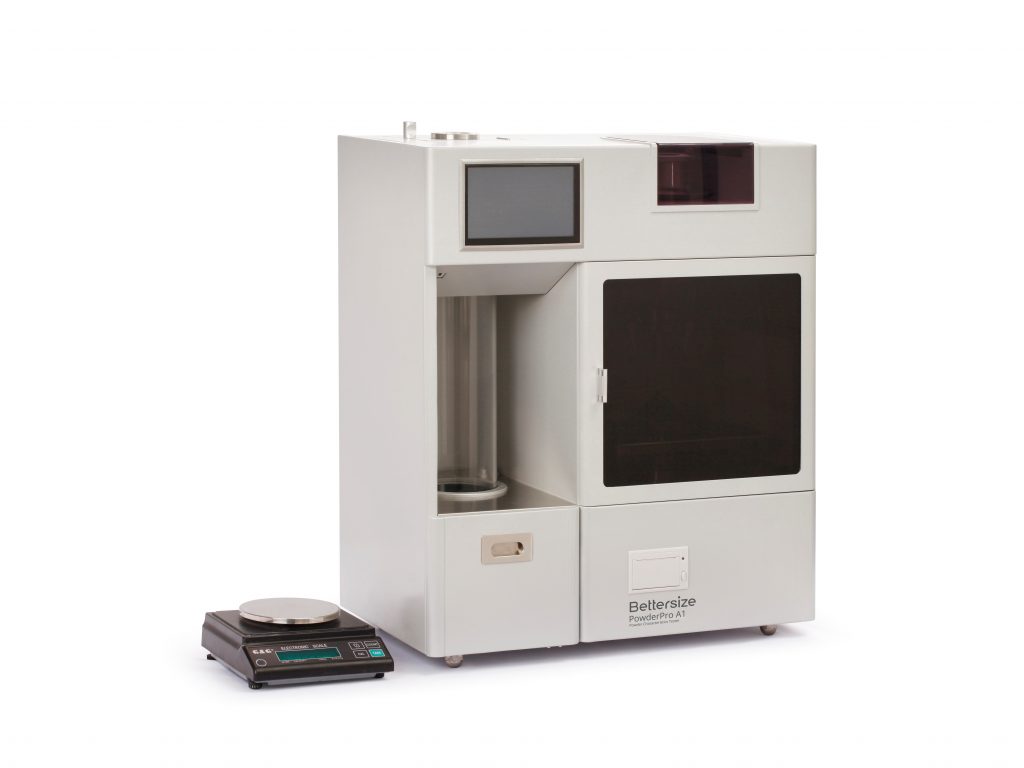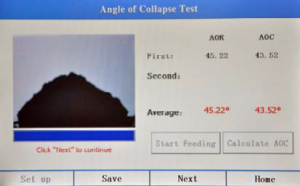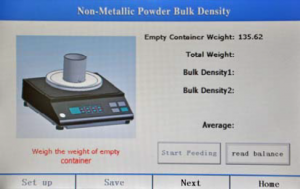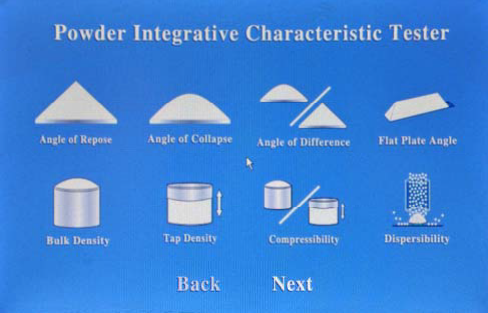
Introduction of PowderPro A1
Powder property is basic characteristic of powder materials which mainly refers to flowability, splashing property and compactness. Study of powder property has important practical meaning for production, processing, packaging, transportation, storage and application of powder. Through automatic control technology, CCD camera technology and touch screen technology, PowderPro A1 intelligent powder characteristic tester makes physical properties measurement into the age of science, intelligent and precision. Specific test items includes angle of repose, angle of collapse, tap density, bulk density, flowability index, etc. The instrument has characteristics of high intelligence, multiple purposes, easy operation, good repeatability, flexible and diverse measurement condition, suitable for various standards, etc. The successful development of the instrument provides a scientific method for precision measurement of powder physical property.
Application fields of PowderPro A1:
The fields of pharmaceutical, battery material, powder coating, non-metallic mine, graphite, food, nonferrous metals, powder engineering design, powder property study and teaching, etc.
Repeatability
Excellent repeatability is achieved thanks to:
-Images of angle of repose and flat plate angle are shot by CCD, and are recognized precisely by software;
-The vibration frequency of vibrating screen is continuously adjustable to ensure that hopper opening can feed sample uniformly;
-All processes of test are operated by instrument automatically which excludes the factors of man-made interference.
Repeatability verification example:
Repeatability of re-sampling test for same sample


Standards for each test index by PowderPro A1
- Test methods for powder angle of repose, bulk density of nonmetal, tap density and compressibility accord with GB/T 16913-2008-4.5.
- Tap density of fixed weight method for metal powder and nonmetal powder accords with GB/T
5162-2006/ISO3953:1993.
- Dispersibility, flat angle angle, uniformity and cohesion have to be measured for calculating Carl flowability index, and accord with American ASTMD6393-08 standard.
- In accordance with 07/2010:20934E (tap density of fixed volume method) of European Pharmacopoeia 7.0 and United States Pharmacopoeia 616 (tap density of fixed volume method), etc
Reliable performance and easy operation
Reliable performance is achieved thanks to:
 - Use of high quality components.
- Use of high quality components.
- Components are inspected and recorded for traceability. A 48-hour failure test before instruments leaves the factory.
- Use of advanced technologies such as dry burning-resistant ultrasonic, auto alignment, dew-point temperature detecting and others
- Comply with CE, FDA 21 CFR Part 11 and ISO 9001-2008 certification
Easy operating:
Adopts touch screen control technology to control the operation of the instrument. The electronic scale is connected to the instrument and weighing data such as the weight of container, the weight of powder and total weight, etc will be transferred to the system automatically. The data will be calculated automatically and be sent to the instrument directly. The result can be printed out. Also, use USB flash disk to export result for further management.

Test and calculation items and concepts of PowderPro A1
--Angle of repose: In the state of static equilibrium, the acute angle between natural stacking slope and bottom horizontal plane of powder is called angle of repose. By the way of electromagnetic vibration, it is formed by powders which freely fall to a specific platform. The angle of repose reflects the flowability of powder directly. If angle of repose is smaller, the flowability is better. If angle of repose is bigger, the flowability is worse. Angle of repose is also called angle of rest or natural angle of slope.
--Angle of collapse: after measuring the angle of repose, impact the stacking powder by external forces, meanwhile, collapse phenomenon may occur on the surface of stacking powder, after that, the acute angle between stacking slope of powder and bottom horizontal plane is called angle of collapse. If the angle of collapse is smaller, the flowability of powder is better.
--Angle of difference: The difference between angle of repose and angle of collapse is called angle of difference. If the difference is bigger, the splash property of powder is better.
--Flat plate angle: lifting up the flat plate which is under natural stacking powder vertically, the average value for the angle between free surface (slope) on the plate and horizontal plane, and the angle which is after impacting. If the flat plate angle is smaller, the flowability of the powder is stronger. Generally, flat plate angle is bigger than angle of repose. Flat plate angle is also known as spatula angle.
--Tap density: after filling a definite weight powder (or volume) into specific container, vibrate the container in definite intensity, times and duration, so as to compress the gap between the particles, and particles are in tight state. The powder density at this time is called tap density.
--Bulk density: it refers to the density that powder is filled in specific container and in natural filled state.
--Compressibility: it refers to the ratio of the difference between tap density and bulk density of powder with tap density. If compressibility is smaller, the flowabilty is better. Compressibility is called compression ratio either.
--Dispersity: after dropping definite powder at a certain height, the percentage that amount drifting outside of collecting tray in total amount of dropping powder is called dispersity. Dispersity is degree of drift powder in the air. It is related to dispersibility, drifting property and splashing property. If dispersity exceeds 50%, it means that the sample has strong tendency of drift.
--Voidage: it refers to the percentage that the gap of particles in complete volume. It will vary as different factors such as particle shape, arrangement structure and particle size, etc. If the particle is sphere, the voidage of powder is around 40%; if the particle is superfine or irregular shape, the voidage of powder is 70-80% or higher.
--Uniformity: It refers to the ratio of D60 and D10 which is calculated by particle size distribution according to sieving method. It is used for coarse powder that has less coherence.
--Cohesion: According to the characteristics of particles in the process of sieving, an explanatory measuring index for the internal tress of particles is called agglutination. If the agglutination is bigger, the flowability of powder is worse. Cohesion applies to fine powder which is easier for agglomeration or micro powder.
--Flowability index: It refers to weighted sum of angle of repose, compressibility, flat plate angle, uniformity and agglutination. Flowability index is related to compressibility.
--Floodability index: It refers to weighted sum of flowability index, collapse angle, difference angle and dispersity.
Specification
| Standard | PowderPro A1 | |
| Chinese standard | GB/T16913-2008 4.5, GB/T1479.1-2011, GB/T5162-2006 | |
| US standard | ASTM D6393-14 | |
| USP | USP32-NF27<616> | |
| EP | EP7.0 07/2010:20934 | |
| Testing Parameter | ||
| Repeatability | ≤3% | |
| Drop height | 3mm or 14mm | |
| Vibration frequency | 50-300 times per minute (continuous adjustment) | |
| Control terminal | Touch screen, mobile and computer | |
| System | ||
| Dimension | 600mm x 350mm x 730mm (L x W x H) | |
| Weight | 42kg | |
| Power supply | AC220V, 50/60Hz, 230W | |






